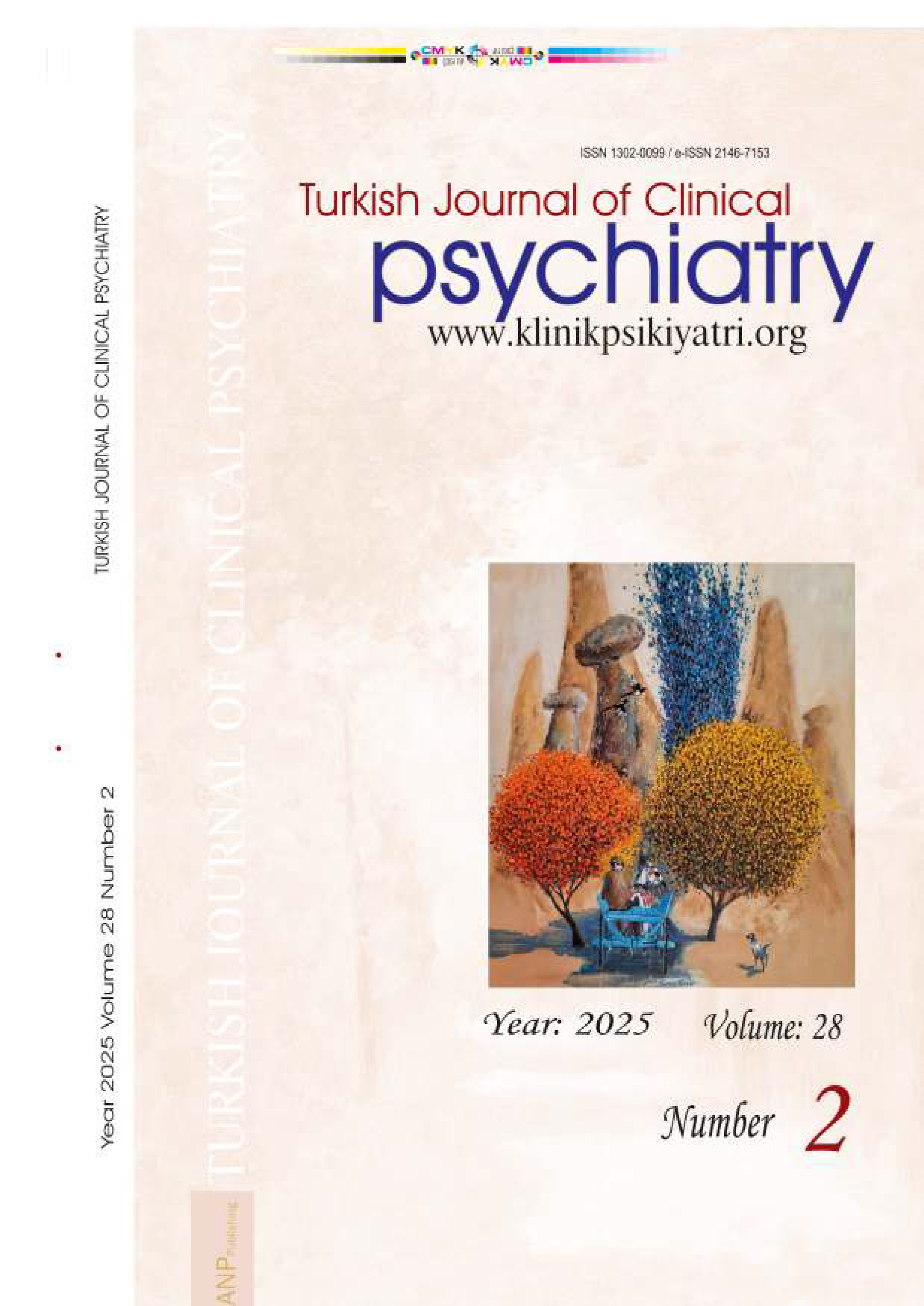





Volume: 19 Issue: 1 - 2016
| EDITORIAL | |
| 1. | Editorial Burhanettin Kaya Page 4 Abstract | |
| RESEARCH ARTICLE | |
| 2. | Sociodemographic And Clinical Characteristics in Medical Students with Attention Deficit Hyperactivity Disorder Filiz Özdemiroğlu, Kadir Karakuş, Çağdaş Öykü Memiş, H. Gülnur Şen, Levent Sevinçok doi: 10.5505/kpd.2016.21931 Pages 5 - 14 INTRODUCTION: The aim of this study was to investigate the prevalence of attention deficit hyperactivity disorder; to compare sociodemographic and clinic variables, and gender differences between medical students with or without ADHD. METHODS: A total of 577 medical students were included in this study. Data were collected by using a sociodemographic questionnaire and the Adult Attention Deficit Disorder/Attention Deficit Hyperactivity Disorder Diagnostic and Assessment Inventory based on DSM-IV. RESULTS: Among 577 students 8% (n=46) were found to have a diagnosis of adult attention deficit hyperactivity disorder according to criteria of DSM-IV. 22 (48%) of them had predominantly inattentive, 14 (30%) had hyperactive, and 10 (22%) had combined type. The rates of regular alcohol use in students with attention deficit hyperactivity disorder was significantly higher than those without attention deficit hyperactivity disorder (p = 0.015). When participants were assessed according to gender, the rates of failing in class and substance use in girls with attention deficit hyperactivity disorder were higher than in girls without attention deficit hyperactivity disorder. Whereas, substance use rates were higher in boys with attention deficit hyperactivity disorder than those without attention deficit hyperactivity disorder. DISCUSSION AND CONCLUSION: Adult attention deficit hyperactivity disorder was found to be 8% of our sample in university students. Regular alcohol consumption rates were higher in students with attention deficit hyperactivity disorder. The rates of failing in class and substance use were higher in girls, substance use were higher in boys with attention deficit hyperactivity disorder |
| 3. | Is Quality of Life Associated with Caregiver Burden and Social Support among Caregivers of Patients with Bipolar I Disorder? Özlem Devrim Balaban, Ali Haydar Küçüktüfekçi, İbrahim Tolga Binbay, Nesrin Karamustafalıoğlu doi: 10.5505/kpd.2016.97269 Pages 15 - 26 INTRODUCTION: The aim of this study is to investigate the relationship between quality of life and burden and perceived social support among caregivers of patients with bipolar I disorder (BPD I). METHODS: Seventy five patients with the diagnosis of BPD I according to the DSM-IV-TR criteria at least for one year and 75 caregivers of these patients for at least one year were included to the study between October 2013 and January 2014. Patients were evaluated with sociodemographic and clinic data form and caregivers were evaluated with sociodemografic data form,World Health Organization Quality of Life Short Form Turkish Version Scale (WHOQOL-BREF-TR), Zarit Burden Interview (ZBI), and Multidimensional Scale of Perceived Social Support (MSPSS). Caregivers were divided into three groups as having mild, moderate and severe burden according to ZBI scores for comparisons. RESULTS: All subdomain scores of WHOQOL-BREF-TR except social domain were significantly lower in caregivers who reported higher burden compared to the caregiver groups with lower degree of burden. It was found to be a significant positive correlation between MSPSS total score and social, environmental and national environmental domains of WHOQOL-BREF-TR, family subdomain of MSPSS and psychological, social, environmental and national environmental domains of WHOQOL-BREF-TR, friends subdomain and physical domain, and significant others subdomain and social, environmental and national environmental domains. Caregiver burden was an important factor to predict the quality of life of the caregivers. DISCUSSION AND CONCLUSION: Quality of life of caregivers of BPD I patients is low. Strategies intended for decreasing burden related to the disease and increasing social support should be developed for improving quality of life. |
| 4. | Risk Taking Behavior: An Evaluation in terms of Childhood Trauma and Self-Esteem İrem Eker, Banu Yılmaz doi: 10.5505/kpd.2016.02996 Pages 27 - 36 INTRODUCTION: The purpose of this study is to investigate the types and the prevalence of risk taking behavior in young adults and its relationship with childhood trauma and self-esteem. METHODS: Data were collected from 126 female and 73 male undergraduate university students aged 18-26 years (mean age 21.13, SD=1.63), using three standardized scales, namely, Childhood Trauma Questionnaire, Coopersmith Self-Esteem Inventory, and Risk Taking Behavior Questionnaire. Besides these standardized measures, an informed consent form was used in order to explain the purpose of the study and the ethical issues, and a demographic information questionnaire was used to determine the characteristics of the participants. RESULTS: The descriptive statistics revealed that the most frequent risk taking behaviors were smoking, drinking alcohol, and fighting whereas the least frequent ones were driving under the influence, and sexual abuse. The correlation analysis indicated a significant positive correlation between risk taking behavior and childhood trauma, and a negative correlation between risk taking behavior and self-esteem. The predictors of the risk taking behavior were found to be sex, age, sexual abuse, and physical abuse according to the results of the stepwise hierarchical regression analysis. DISCUSSION AND CONCLUSION: This research indicated the relationship between risk taking behavior and childhood trauma and self-esteem. The findings were discussed in terms of their implications with references to the related literature. |
| REVIEW | |
| 5. | Borderline Personality Disorder and Its Relation With Crime And Violence: A Review Bengisu Nehir Aydın doi: 10.5505/kpd.2016.83703 Pages 37 - 44 Borderline personality disorder is a pattern beginning in early adulthood, appearing in various context such as instability in interpersonal relationships, self-image, affect and marked impulsivity. It is estimated that the prevalence of borderline personality disorder in main population is between 1.6 - 5.9 %. Borderline personality traits take place in the risk factors of crime and violence in addition to being young man and substance abuse in many studies which were carried out with criminals. It is reported that 25-50 % of prisoners have borderline personality traits. High risk occurs in terms of violence environment when low capacity in managing anger responses, impulsive behaviors are combined with unstable affect, impulsivity and fear of abandonment. Borderline personality disorder is also important in terms of the victim who is effected from the crime. Victimization is common in both childhood and adulthood of borderline patients. Because of the difficulty in interpersonal relationships, they often find themselves in relationships which include violence and abuse. Violence is a base for a victim turning him/her to a criminal. Social politics and treatment approaches have importance to decrease violence and crime rates and brake the vicious cycle between being victim and perpetrator. Protecting the criminals, who have been the victim at one point in their life, from stigmatization is also important. In this article, borderline personality traits and its connection with impulsivity, victimization, gender differences and comorbidity with other psychopathological conditions in terms of crime, will be stated. |
| CASE REPORT | |
| 6. | Coping Skills Of People With Amputation: Case Presentation İpek Özsoy, Ülgen H. Okyayuz doi: 10.5505/kpd.2016.30074 Pages 45 - 51 Amputation is the process of seperation of a part or the whole of the limb form the body, because of medical reasons. If the organ will not cure, or if this situation causes a risk for patient's life, amputation will be needed. Amputation is one of the oldest operations in history. Extremity amputations have both physical and psychological results. Amputaion is a situation that its meaning for individual is not only an organ loss but also loss of body image, function, work and relationships. Individuals give reactions against all the types of loss and they go through a periods which is called mourning period. In this period, people with ampuations's personal characteristics, family support, social support, cultural background and meaning that they give for the loss effects their psychosocial reactios. Coping with an illness, is a dynamic period that changes by the time and coping skills of infividual effects his or her psychosocial reactions. In this study, it is aimed that get across by making synthesize the effects and role of trauma, loss and mour ning reactions in idividual's life, effects of his or her coping skills and reactions, with the light of the presented case. |
| 7. | Interesting Suicidal Attempt of Schizophrenia Patient: Nine Cylindrical Batteries in Abdomen Serpil Bayındır, Fatma Koçyiğit, Mustafa Kahraman doi: 10.5505/kpd.2016.43531 Pages 52 - 55 Foreign body ingestions are less common emergency problems in adults than in children. This rate more increases in patients who has comorbid conditions, especially using with psychoactive substances accompanying psychiatric disorders. The suicidal attempts are seen in % 10 of the schizophrenia patients which is particularly associated with their mood swings and disruptions of the treatment. When the schizophrenia patients admitt to the hospital have presented with a self-destructive impulsivity and command hallucinations foreign body ingestion must keep in mind among the reasons. A day before the schizophrenia patient who has ingested 14 mm diameter, 50 mm length and 9 g. lenght nine cylindrical batteries, was applied urgent endoscopy. Patient was followed with serial radiography and clinic properities. After approximately 24 hours of arrival the batteries are excreted in the feces without complication Especially in children most of suisidal attempts about ingested the button batteries has been reported in literature, but we couldn’t find out this number any case in adults. This case which has a greater number of foreign bodies, using drugs irregular and alcohol in psychatric patients may increase the number of suisidal attempts has been reported with literatüre. |










